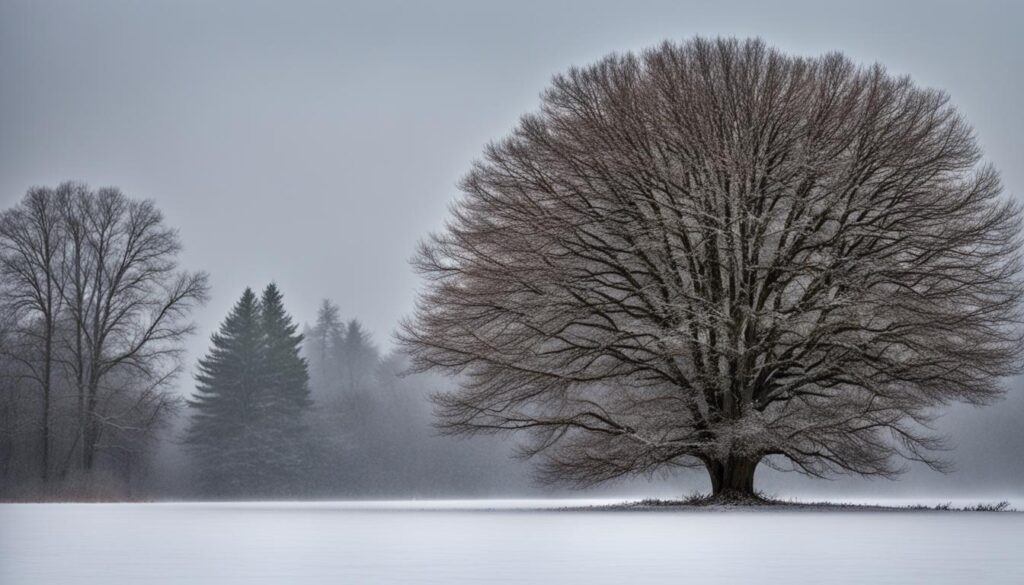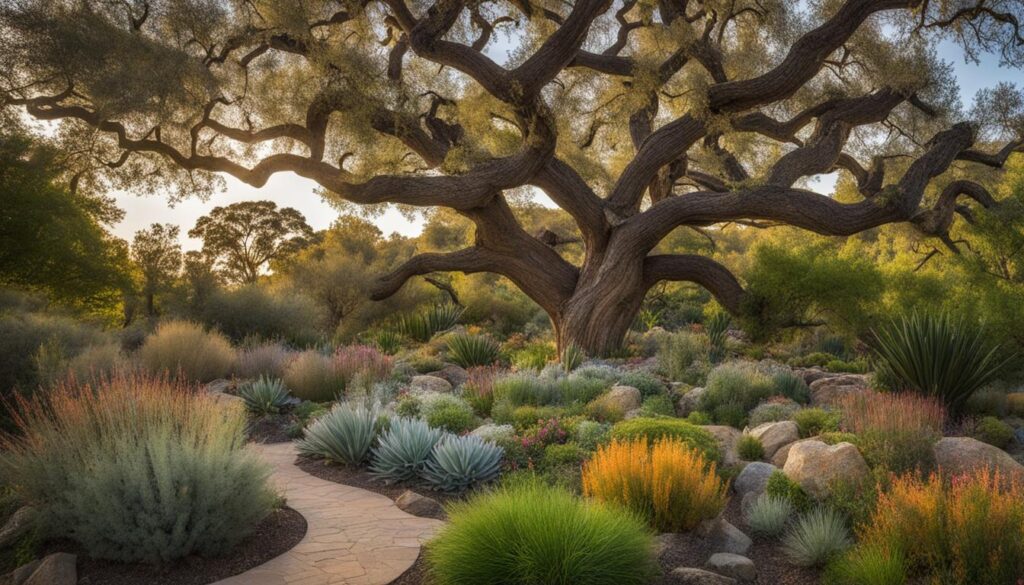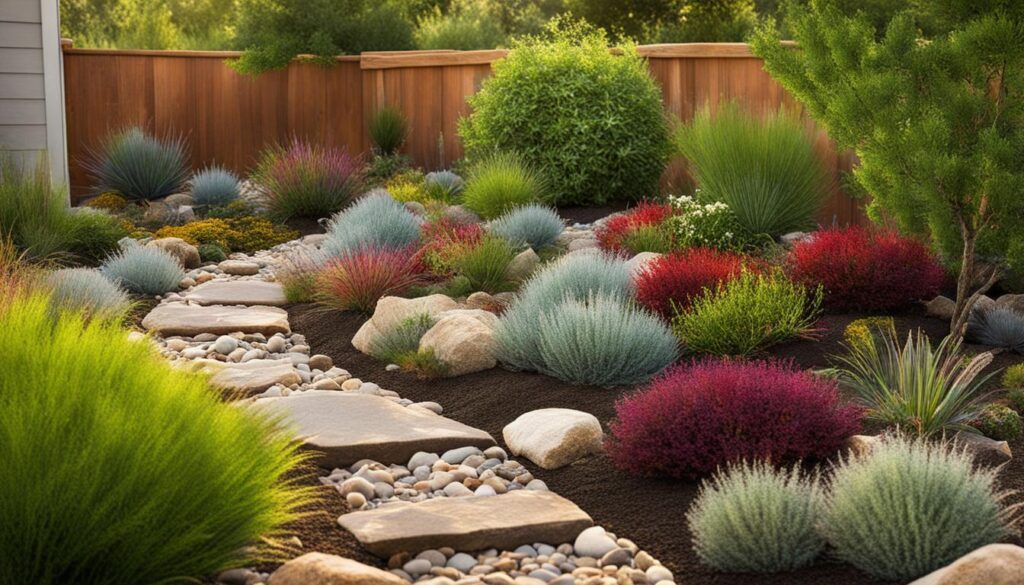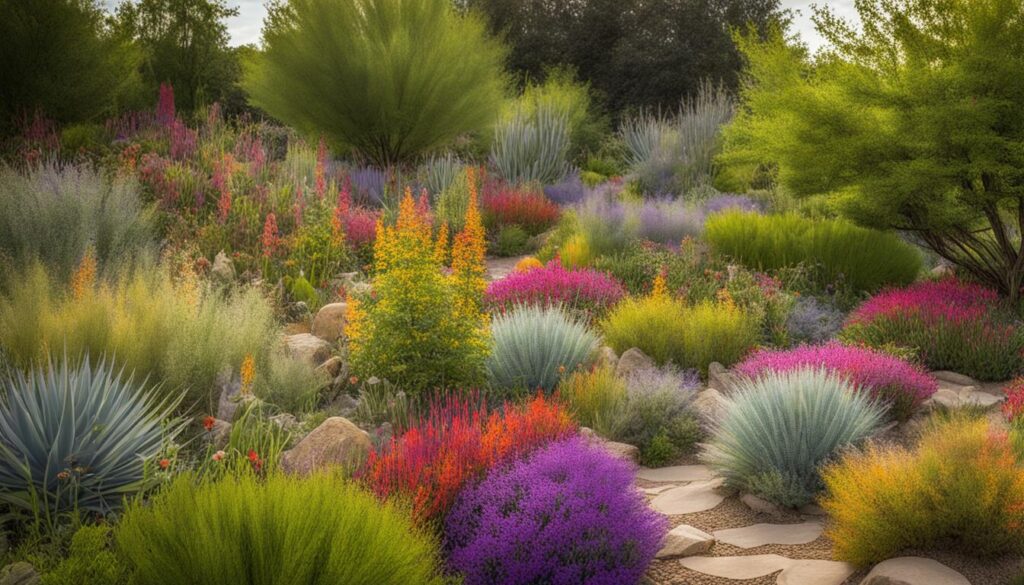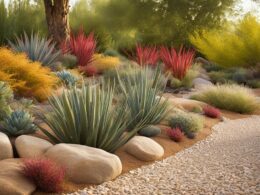Are you looking for a sustainable gardening technique that can thrive in cold climates? Look no further than xeriscaping with native plants. Native plants are well-suited for xeriscaping as they are adapted to local weather conditions and require less water. In this ultimate guide, we will explore how to create a thriving xeriscape garden in cold climates, giving you a beautiful and eco-friendly landscape.
Key Takeaways:
- Native plants are ideal for xeriscaping in cold climates as they are adapted to local weather conditions.
- Xeriscape gardens in cold climates require careful consideration of winter gardening challenges and proper plant selection.
- Hydrozoning and proper drainage are crucial for successful xeriscaping in cold climates.
- Contrary to popular belief, xeriscape gardens can be vibrant and colorful with a diverse range of plant selections.
- There are numerous native plant options for xeriscaping in cold climates, each with unique characteristics and requirements.
Winter Gardening Challenges in Xeriscaping
Winter gardening in xeriscaping presents unique challenges, especially in cold climates. The combination of freezing temperatures, reduced sunlight, and limited rainfall can make it difficult for plants to thrive. To successfully maintain a xeriscape garden during the winter, it’s important to understand and address these challenges.
One of the main challenges in winter gardening is the lack of rainfall. Xeric plants are adapted to survive with minimal water, but during the winter months, regular irrigation may be necessary to ensure their survival. This can be achieved through manual watering or using a drip irrigation system, which delivers water directly to the root zone while minimizing water loss due to evaporation.
Another challenge is the effect of the cold on plant health. Freezing temperatures can damage or kill tender plants, so it’s important to select cold-hardy varieties that are suitable for your specific climate. Providing protection against extreme cold and dryness by locating plants in sheltered areas or using temporary coverings, such as burlap or frost blankets, can help prevent damage.
“Winter gardening in xeriscaping requires careful consideration and planning to ensure the survival and health of your plants,” says gardening expert Jane Smith. “By selecting the right plants, providing adequate irrigation, and protecting them from extreme cold, you can create a thriving xeriscape garden even in the winter.”
Table: Recommended Winter-Resistant Native Plants for Xeriscaping
| Plant | Hardiness Zone | Water Needs | Height |
|---|---|---|---|
| Juniperus scopulorum (Rocky Mountain Juniper) | 3-7 | Low | Up to 30 ft |
| Penstemon strictus (Rocky Mountain Penstemon) | 3-8 | Low | 1-3 ft |
| Agave parryi (Parry’s Agave) | 5-10 | Low | 1-2 ft |
| Sedum lanceolatum (Lanceleaf Stonecrop) | 4-8 | Low | 4-6 in |
These native plants are well-suited for xeriscaping in cold climates as they are adapted to tolerate low water availability and freezing temperatures. They can add visual interest and color to your winter garden while requiring minimal maintenance.
In conclusion, winter gardening in xeriscaping comes with its own set of challenges. However, with proper planning, plant selection, irrigation, and protection measures, you can create a thriving xeriscape garden even in cold climates. By embracing native plants that are adapted to the local weather conditions and conserving water through xeriscaping techniques, you can have a beautiful and sustainable garden all year round.
The Importance of Native Plants in Xeriscaping
Xeriscaping, a sustainable gardening technique that conserves water, can be enhanced by incorporating native plants into your landscape. Native plants are crucial for xeriscaping in cold climates due to their adaptability to local weather conditions and soil types. These plants have evolved to withstand harsh winters, limited rainfall, and other challenging factors, making them resilient choices for xeriscape gardens. Additionally, native plants offer a range of ecological benefits that contribute to the overall health and biodiversity of the local ecosystem.
One of the primary advantages of using native plants in xeriscaping is their reduced water requirements. These plants have adapted to the local climate and are well-suited to the available rainfall patterns. They have developed deep root systems that can access water resources more efficiently, reducing the need for supplemental irrigation. By choosing native plants, you can significantly decrease your water usage and still enjoy a vibrant and thriving landscape.
Native plants have evolved to provide essential resources for local wildlife. They offer food sources, shelter, and nesting materials for birds, bees, butterflies, and other pollinators. By including native plants in your xeriscape garden, you create an inviting habitat that supports biodiversity and helps sustain crucial pollinator populations.
In addition to their water-saving and wildlife-friendly qualities, native plants also contribute to wildfire prevention. Many native species have fire-resistant characteristics such as low resin content and high moisture content, which can help protect your property during the dry seasons. By incorporating these plants into your xeriscape garden, you can create a natural buffer zone that reduces the risk of wildfire spread.
Benefits of Native Plants in Xeriscaping:
- Reduced water requirements
- Support for local wildlife and pollinators
- Fire-resistant qualities for wildfire prevention
- Promotion of biodiversity and ecosystem health
- Integration with the local landscape
Table: Examples of Native Plants for Xeriscaping in Cold Climates
| Plant Name | Description | Water Requirements | Sun Exposure |
|---|---|---|---|
| Sedum spectabile | Also known as “Autumn Joy,” this perennial has showy clusters of pink flowers that attract butterflies. | Low | Full sun to partial shade |
| Echinacea purpurea | Commonly known as Purple Coneflower, it produces vibrant daisy-like flowers that attract bees and butterflies. | Moderate | Full sun to light shade |
| Amelanchier laevis | Also called Serviceberry, it is a small tree known for its spring flowers, edible berries, and vibrant fall foliage. | Low to moderate | Full sun to part shade |
Hydrozoning in Xeriscaping
Hydrozoning is a fundamental concept in xeriscaping, especially when it comes to winter gardening in cold climates. By grouping plants with similar water needs together, you can maximize water efficiency and ensure the health and vitality of your xeriscape garden.
When implementing hydrozoning in your garden, it’s important to consider the specific water requirements of different plants. Grouping water-wise plants, such as succulents and drought-tolerant perennials, together can help minimize water usage. These plants have the ability to retain moisture for longer periods, making them well-suited for xeriscaping.
On the other hand, native perennials can be grouped separately, as they are adapted to local weather conditions and require less water. This approach allows you to tailor your watering schedule to meet the needs of each group, optimizing water usage and promoting the overall health of your xeriscape garden.
| Group | Water Requirements |
|---|---|
| Water-Wise Plants | Low |
| Native Perennials | Moderate |
By strategically hydrozoning your xeriscape garden, you can conserve water while maintaining a beautiful and sustainable landscape. Keep in mind that proper maintenance, including regular monitoring of soil moisture and adjusting irrigation as needed, is crucial to the success of hydrozoning in xeriscaping.
Proper Drainage for Xeriscaping in Cold Climates
Proper drainage is a crucial aspect of xeriscaping, particularly in cold climates with rocky environments. Xeric plants, known for their ability to thrive in low-water conditions, require well-draining soil to prevent waterlogging and root rot. By implementing effective drainage strategies in your xeriscape garden, you can ensure the long-term health and vitality of your plants.
One approach to improving drainage is to use raised mounds or berms when planting xeric plants. These raised areas allow excess water to flow away from the plants’ root zones, preventing water saturation. Additionally, incorporating organic matter into the soil can improve its drainage capabilities. Organic matter helps to break up heavy clay soils, allowing water to flow through more easily.
Effective Drainage Techniques:
- Use raised mounds or berms to divert water away from plant roots.
- Incorporate organic matter into the soil to enhance drainage.
- Ensure that the soil has a balanced composition, with a low clay content.
- Consider installing perforated drainage pipes or gravel trenches in areas prone to excessive moisture.
By implementing these techniques, you can create an environment in which xeric plants can thrive, even in cold climates. Remember that proper drainage not only helps to prevent water-related issues but also promotes healthy root development and overall plant growth.
| Plant | Watering Needs | Preferred Soil Type | Best Drainage Strategy |
|---|---|---|---|
| Sedum rubrotinctum (Jelly Bean Plant) | Low to moderate | Well-draining, sandy soil | Raised mounds or berms |
| Pachysandra procumbens (Allegheny Spurge) | Low to moderate | Moist, well-draining soil | Perforated drainage pipes |
| Ophiopogon japonicus (Dwarf Lilyturf) | Low to moderate | Loamy, well-draining soil | Gravel trenches |
| Juniperus conferta (Shore Juniper) | Low | Well-draining, sandy soil | Raised mounds or berms |
As shown in the table above, different plants have varying water needs and soil preferences. Adapting the drainage strategy according to the specific requirements of each plant can help you create an optimal environment for your xeriscape garden.
The Myth of Bland Xeriscape Gardens
One common misconception about xeriscape gardens is that they are limited to a monotonous collection of cacti and succulents. However, this couldn’t be further from the truth. Xeriscape gardens can be just as vibrant and colorful as traditional gardens, showcasing a wide variety of plants that thrive in water-wise environments.
By carefully selecting a diverse range of xeriscape plants, you can create a visually appealing landscape while conserving water and reducing maintenance. Consider incorporating flowering plants such as lavender, yarrow, and coneflowers to add pops of color. These plants not only bring beauty to your garden but also attract pollinators like bees and butterflies.
Shrubs like Russian sage, Indian hawthorn, and butterfly bush can provide structure and texture to your xeriscape garden. These plants offer interesting foliage, colorful blooms, and sometimes even fragrant flowers. Don’t forget about trees, too! Desert willows, junipers, and mesquites are just a few examples of trees that can thrive in xeriscaping and add height and shade to your outdoor space.
Creating a Colorful Xeriscape Garden
To create a truly colorful xeriscape garden, it’s important to consider the different bloom times and textures of the plants you choose. By selecting plants that flower at different times throughout the year, you can ensure a constant display of color in your garden. Mixing plants with different leaf shapes and sizes also adds visual interest and depth.
| Plant | Bloom Time | Color |
|---|---|---|
| Lavender | Spring and summer | Purple |
| Yarrow | Summer | Various colors |
| Coneflowers | Summer and fall | Pink, purple, white |
| Russian sage | Summer | Purple |
| Indian hawthorn | Spring | Pink or white |
| Butterfly bush | Summer | Purple, pink, white |
With the right combination of xeriscape plants and thoughtful planning, you can create a garden that bursts with vibrant colors throughout the year. Don’t be afraid to experiment and mix different plants together to create a visually stunning and water-wise landscape.
Recommended Native Plants for Xeriscaping in Cold Climates
When it comes to xeriscaping in cold climates, choosing the right native plants is essential for a successful and sustainable garden. Native plants are adapted to the local weather conditions and can withstand the challenges posed by winter temperatures and limited rainfall. Here are some recommended native plants that thrive in cold climates:
| Native Plant | Description | Requirements |
|---|---|---|
| Sedum rubrotinctum (Jelly Bean Plant) | This succulent plant features jelly bean-shaped leaves that turn red under bright sunlight. | Well-drained soil, full sun |
| Pachysandra procumbens (Allegheny Spurge) | This low-growing groundcover has attractive green foliage and delicate white flowers. | Partial shade to full shade, moist soil |
| Ophiopogon japonicus (Dwarf Lilyturf) | This grass-like plant forms dense clumps and produces small purple or white flowers. | Partial shade to full sun, well-drained soil |
| Juniperus conferta (Shore Juniper) | This evergreen shrub has low spreading branches and blue-green foliage. | Full sun, well-drained soil |
These native plants have unique characteristics and requirements that make them well-suited for xeriscaping in cold climates. By incorporating them into your garden, you can create a beautiful and sustainable landscape that thrives even in harsh weather conditions. Remember to provide the necessary care and maintenance to ensure the health and longevity of your native plants.
With the right selection of native plants for xeriscaping in cold climates, you can conserve water, support the local ecosystem, and enjoy a thriving garden all year round. Consider these recommendations when planning your xeriscape garden and create a landscape that is both environmentally friendly and visually appealing.
How Can I Incorporate Native Plants for Xeriscaping in a Cold Climate?
Incorporating sustainable xeriscaping with native flora in a cold climate involves selecting hardy, drought-tolerant plants native to the region. Look for species such as coneflowers, prairie grasses, and sedums that can thrive in colder temperatures while reducing the need for irrigation and minimizing environmental impact.
Can Native Plants for Xeriscaping in Cold Climates Be Used in Other US Regions?
Native plants for xeriscaping in cold climates may not always adapt to warmer regions. However, a selection of climateappropriate xeriscaping plants us can thrive across varied US zones, offering sustainable landscaping solutions beyond their native habitat when carefully chosen to match local ecological conditions.
Conclusion
Xeriscaping in cold climates using native plants offers numerous advantages for sustainable gardening. By carefully selecting plants adapted to local weather conditions, homeowners can create beautiful and resilient landscapes while conserving water.
Winter gardening in xeriscaping gardens can present challenges due to low temperatures and limited rainfall. However, with the right plant selection and proper maintenance, a thriving xeriscape garden is possible even in cold climates.
Hydrozoning, proper drainage, and the misconception that xeriscape gardens are bland are important factors to consider. By grouping plants with similar water needs, promoting good water drainage, and choosing a diverse range of plants, xeriscape gardens can be both visually appealing and eco-friendly.
With the use of native plants, xeriscape gardens not only conserve water but also provide ecological benefits. Native plants are adapted to local weather conditions and provide shelter and food for wildlife, while also protecting yards from wildfires. By incorporating native plants, homeowners can create sustainable landscapes that will thrive and benefit the local ecosystem for years to come.






